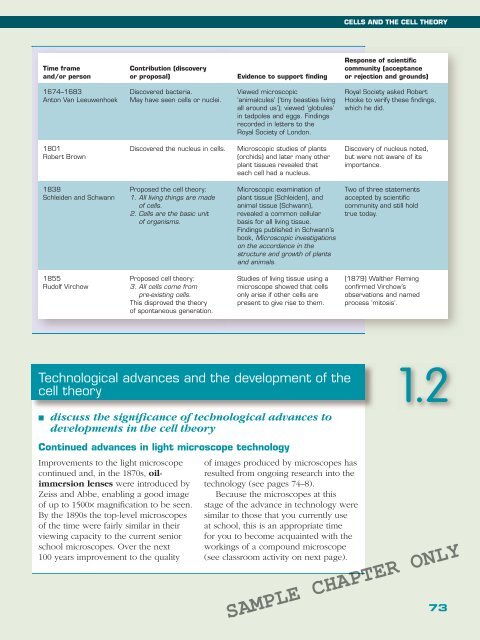BIOLOGY IN FOCUS
BIOLOGY IN FOCUS
BIOLOGY IN FOCUS
Create successful ePaper yourself
Turn your PDF publications into a flip-book with our unique Google optimized e-Paper software.
CELLS AND THE CELL THEORY<br />
Time frame<br />
and/or person<br />
Contribution (discovery<br />
or proposal)<br />
Evidence to support finding<br />
Response of scientific<br />
community (acceptance<br />
or rejection and grounds)<br />
1674–1683<br />
Anton Van Leeuwenhoek<br />
Discovered bacteria.<br />
May have seen cells or nuclei.<br />
Viewed microscopic<br />
‘animalcules’ (‘tiny beasties living<br />
all around us’); viewed ‘globules’<br />
in tadpoles and eggs. Findings<br />
recorded in letters to the<br />
Royal Society of London.<br />
Royal Society asked Robert<br />
Hooke to verify these findings,<br />
which he did.<br />
1801<br />
Robert Brown<br />
Discovered the nucleus in cells.<br />
Microscopic studies of plants<br />
(orchids) and later many other<br />
plant tissues revealed that<br />
each cell had a nucleus.<br />
Discovery of nucleus noted,<br />
but were not aware of its<br />
importance.<br />
1838<br />
Schleiden and Schwann<br />
Proposed the cell theory:<br />
1. All living things are made<br />
of cells.<br />
2. Cells are the basic unit<br />
of organisms.<br />
Microscopic examination of<br />
plant tissue (Schleiden), and<br />
animal tissue (Schwann),<br />
revealed a common cellular<br />
basis for all living tissue.<br />
Findings published in Schwann’s<br />
book, Microscopic investigations<br />
on the accordance in the<br />
structure and growth of plants<br />
and animals.<br />
Two of three statements<br />
accepted by scientific<br />
community and still hold<br />
true today.<br />
1855<br />
Rudolf Virchow<br />
Proposed cell theory:<br />
3. All cells come from<br />
pre-existing cells.<br />
This disproved the theory<br />
of spontaneous generation.<br />
Studies of living tissue using a<br />
microscope showed that cells<br />
only arise if other cells are<br />
present to give rise to them.<br />
(1879) Walther Fleming<br />
confirmed Virchow’s<br />
observations and named<br />
process ‘mitosis’.<br />
Technological advances and the development of the<br />
1.2<br />
cell theory<br />
■ discuss the significance of technological advances to<br />
developments in the cell theory<br />
Continued advances in light microscope technology<br />
Improvements to the light microscope<br />
continued and, in the 1870s, oilimmersion<br />
lenses were introduced by<br />
Zeiss and Abbe, enabling a good image<br />
of up to 1500× magnification to be seen.<br />
By the 1890s the top-level microscopes<br />
of the time were fairly similar in their<br />
viewing capacity to the current senior<br />
school microscopes. Over the next<br />
100 years improvement to the quality<br />
of images produced by microscopes has<br />
resulted from ongoing research into the<br />
technology (see pages 74–8).<br />
Because the microscopes at this<br />
stage of the advance in technology were<br />
similar to those that you currently use<br />
at school, this is an appropriate time<br />
for you to become acquainted with the<br />
workings of a compound microscope<br />
(see classroom activity on next page).<br />
SAMPLE CHAPTER ONLY<br />
73
















